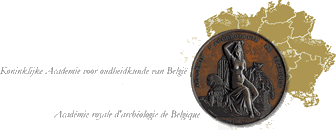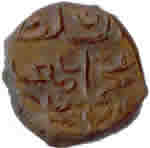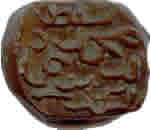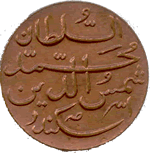by: Raf Van Laere
of Belgium
|

Raf Van
Laere is a member of the board of directors of de
Koninklijke Academie voor Oudheidkunde van België
or the Royal Academy of Archaeology of Belgium. This
is a non-profit organisation founded in 1842. The
Academy is registered in Brussels and is placed under
the Gracious Protection of His Majesty the King of
the Belgians.
This article is extracted from Numismatic Digest
of the Numismatic Society of Bombay (India) edited
by Dr. Parameshwari Lal Gupta Volume III. June 1979.
Part 1. pp 48-57 and reproduced here with the kind
permission and encouragement of Raf Van Laere
|
Page 48
INTRODUCTION

Half läri coin of Mohamed Muinuddine I Iskander
1823 |
The Republic of Maldives consists of a
large number of small islands and atolls situated on the south-west
of the Indian Subcontinent1.
Only part of these hundreds of islands is inhabited. The capital
Male or Mahal2
is located on one of the major islands in the centre of the
archipelago. The history of this small republic, which gained
independence in 1965, did not preoccupy the minds of modern
historians. Apart from some indications spread throughout
the main works on world history
3 the man of science will have to be pleased
with the stories found in books which are not only difficult
to find but also largely out-dated
4.
Before the conversion of the population
to Islam, during the twelfth century
5 everything is rather obscure. It has been suggested
that the islands were colonised even before the first century
AD by the Singhalese. Anyhow the islands were inhabited at
that time since Ptolemy 6
mentioned some islands to the south-west of India.

Half läri coin of Mohamed Imaduddine IV Iskander
1860 |
The racial tripartition of the population
of the islands 7 seems
to reflect some migration on which written sources do not,
or very little inform us. The original population seems to
have some ethnical relation either to the Singhalese, or to
the Malayans 8.
Nowadays they concentrate on the southern atolls. From the
beginning of their arrival early in the twelfth century the
people of Arabian blood concentrated on the atoll Male.
The Dravidian infiltration in the north
seems to have been due to the influence of the successive
empires in South India9
and to the incursions of
Footnotes
to Page 48
- For practical reasons all anno Hegira dates have
been converted to anno Domini dates unless specified
otherwise.
- Mahal is the indigenous form of the Arab Maléa.
The inhabitants of the Maldives speak a language which
is related to the Singhalese but written in an alphabet
that is derived from the Arab alphabetb:
see e.g. C.H.B Reynolds, Buddhism and the Maldivian
Language. in L. Cousin. (ed). Buddhist studies
in honour of I.B. Horner. Dordrecht 1974. p 193
- 198.
- e.g.: in Fischer Weltgeschichte, part 17
Indien. published under the direction of Ainslie T.
Friedrich Wilhelm. Frankfurt-Main. 1967.
- See the bibliography by Tim J. Browder. Maldive
Islands Money. Santa Monica 1969. p. 18 - 20
and T.W. Haig. Maldives in L'Encyclopédie
de l` Islam....part 3. Leiden and Paris 1936
p. 216.
- According to the Chronicles of the Kings of Malé
(Fischer Weltgeschichte p 175) the official
conversion took place in 1153 A.H. or a little later.c
- Ptolemy worked during the years 127 till 144 AD.
see e.g. map 1 in R.F. Treharne & Harold Fullard,
Muir's historical atlas Ancient and Classical.
London 1963.
- It goes without saying that none of the "races"
on the Maldives is pure. We take only in consideration
ethnographical aspects as does e.g. Haig op cit.
- Heinrich Berghaus. Allgemeiner ethnographischer
Atlas oder Atlas der Völkerkunde. Gotha.
1852. map 14.
- During the eleventh century the Maldive Islands
were annexed by the Chola Empire (Fischer
|
Maldives
Royal Family Notes to page 48
- Malé is the indigenous term for the Maldive
capital. Mahal was the Arabic corruption of Malé.
- The current Maldive script called Thaana, to which
Chris Reynolds referred was not derived from the Arabic
alphabet. The first nine consonants were derived from
the Arabic numerals, the second nine consonants from
the older Maldive Divehi numerals and the rest of
the consonants from the these eighteen consonants.
The vowels were inspired by the Koranic diacritical
marks. The Islamic mullahs intended to replace the
Divehi alphabet by Arabic in order to obliterate the
Maldive heritage as part of the colonial designs of
Arab imperialism. The Thaana alphabet was invented
by Maldive civil intellectuals to defy the Islamic
mullahs.
- The date of conversion of the King Dhovemi (reigned
AD 1141 - 1166) whose regnal name was Siri Bavanaadheettha
in Malé was AD 1153. Addu atoll and many other
islands converted in AD 1127. The Maldive authorities
today disregard the latter date as it threatens the
supremacy of the Malé government.
|
Page 49
pirates from the Malabar coast1.
It was probably due to this particular influence that a woman
was able to become sultan during the fourteenth centurya.
The illustrious Arab historian Ibn Battüta stayed for
a year (744 A.H.) in the Maldives and left us a historical
treatise which corresponds fairly well with an indigenous
royal chronicle. From the seventeenth century on we are much
better informed thanks to the travels of some Europeans as
e.g. Pyrard de la Val, who was captive on the Maldives for
several years.
In 1518 A.D. the Portuguese established
a factroy but only in 1645 A.Db.
the Maldivians were definitely included into European colonisation.
That year, under the pressure of the attacks of pirates, Mäpillas
or Mophalas, originating from the Malabar coast, the Sultan
of the Twelve Thousand Islands Mohamed Imad-al-Din ibn Aminac
(1619-1648 A.D.) put himself under the protection of the Dutch,
who were, at that time masters of Sri Lanka. After a time
the English succeeded the Dutch but it does not seem that
clonization had a impact on daily lives in the interior of
the country. Apart some trade factories and the payment of
tribute to the colonizers everything was kept the same. The
power of the sultan does not seem to have suffered a lot.
It are probably larins from the tribute
to the Dutch that have been countermarked JAVA (  ) to make them legal tender in their colonies in Insulinde.2
) to make them legal tender in their colonies in Insulinde.2
THE BEGINNINGS OF COINAGE
Before the introduction of coinage, the
cowrie, a small white shell with the shape of a coffee
bean seems to have been the main currency.3
One supposes that the Maldives were the principal production
center of this kind of money that was exported as far as China
and West-Africa.4
The transition of this moneyless economyd,
in which the cowrie played an extremely important role into
a monetary economy was marked by a transitory phase, during
Footnotes
to Page 49
- Haig op.cit.
- Bowder op.cit. fig VI gives a good picture of
this countermark. A counter-marked double larin
dated 1189 A.H./1775 A.D. was recently sold in U.S.A.
by Scott Semans.
- For the role of the cowrie in a-monetary societies
in Africa and Asia see e.g. A. Hingston Quiggin,
A survey of primitive money, New York and
London 1970 (rep). Paul Einzig, Primitive money,
Oxford e.a. 1966, J. Allen, The coinage of the Maldive
Islands with some notes on the cowrie and
the lärin NC, 4th ser., 12 (1912),
p 313-332 and pl. XX and Fischer Weltgestitche,
where Eduardo Barbarosa is quoted, who visited the
islands in the sixteenth century. In theory only
cypraea moneta was used as money but also
other shells of the same family were used sometimes
in some a-monatary societies.
- Some other production centers existed e.g. the
coast of West Africa and Oceania so that the mass
of the Maldivian export went to India and China,
where the cowrie from the highest antiquity on had
a great importance, see A.B. Coole. The influence
of the cowrie shell upon the written language. ONS
Newsletter 16 (Feb 1972)
|
Maldives
Royal Family Notes to page 49
- There were female sovereigns in the Maldives prior
to the fourteenth century. At one stage before the
Islamic conversion, female rulers were the norm
rather than the exception. Until 1964, Maldive law
allowed a female sovereign. In 1952, a female sovereign
was almost installed but was vetoed by the mullahs
who were, by then, gaining power. Under pressure
from the mullahs, the constitution of 1964, for
the first time, provided that the head of state
should be a male.
- Van Laere is one of the few writers who have acknowledged
the fact, albeit implicitly, that European colonial
influence did not begin with the Portuguese. What
is now regarded by the Maldive authorities as Portuguese
rule in the mid to late 16th century
was in fact the reign of a Maldive Christian king.
It is now anathema even to acknowledge the historical
existence of non-Muslim Maldivians after the Islamic
conversion. Present day Maldivians cannot be allowed
even to contemplate such a possibility.
- Matriarchy is evidenced in the name of this 17th
century king. He was named as the son of his mother
Amina (ibn Amina) rather than his father Umar. By
the 17th century this was the exception
but until the thirteenth century the genealogy of
almost all sovereigns were recorded on the female
line.
The Maldives was a matriarchal society in which
female lineage took precedence. This is still the
case in the Maldive-speaking Indian island of Minicoy.
Even today, both men and women of Minicoy take the
family name of their mothers. Over the years, and
particularly since the 1970s oil crisis, this and
other indigenous systems are rapidly being phased
out. The increasingly powerful Islamic mullahs acting
in the interests of their powerful Arab patrons
are in the process of stamping out all traces of
the Maldive national character and replacing it
with the Arab culture.
- It is perhaps not correct to call a society that
used cowrie exclusively for money as a moneyless
society. There is little difference between an extremely
durable medium of exhange extracted from the ocean
and one that is mined from riverbeds and soil (metal)
or for that matter processed wood-pulp with ink-marks
(paper money). They are all rather primitive compared
to electronic ledger entries (modern money) and
electronic funds transfer at the point of sale.
|
Page 50

Four läri coin of Mohamed Shamsuddine III Iskander
1915
|

Siri Kula Sundhura Katthiri Bavana
(Mohamed Shamsuddine III Iskander)
King of Twelve Thousand Isles and Sultan of the Maldives
(reigned 1892 and 1903-1933) |
which the hairpin lärin
made its appearence. Thanks to Pyrard de la Val1
we knew that up to 1602 A.D. lärins were current
in the Maldives, this without any doubt under Indian influence.2
The coinage of these primitive lärins even
continued after the introduction of circular coins.3
This article is concerned only with the circular coinage
of the Maldives.4
Normal coinage or, with other words the
minting of circular coins most probably started during the
reign of Ibrahim Sikandera
I ibn Mohamed (1648-1687 A.D.). The circular lärins
that were minted had the same weight as the primitive hairpin
lärins (4.8 grammes) and inherited also their name
lärï. It is likely that the circular
shape was introduced at the demand of the Dutch. They could
without a doubt introduce much easier circular coins to
their other colonies rather than coins with the shape of
a hairpin.
METAL DENOMINATIONS
AND MINTING TECHNIQUES
The first circular lärins were,
just as their Indian ancestors minted from high quality
silver.5 But
very soon the quality tended to be neglected and from the
second half of the eighteenth century, larins of bronze
appear.6 This
fall in quality of the monetary metal was probably caused
by the constant need for silver for the payment of tribute
to the subsequent colonizers. But this was currently not
the only reason; even the primitive lärin loses
value in this period. 7
Footnotes
to Page 50
- Quiggin. op.cit. p. 198
- The Sultanate of Bijapur at the west coast of
India emitted lärins. Especially those
of Ali Adil Shah II (1067-1083 a.H/1656-1672 a.D.)
are well known. Lärins dated from
1071 a.H. (1660 a.D.) and 1077 a.H. (1666 a.D.)
are well known. Lärins dated from
1071 a.H. (1660 a.D.) and 1077 a.H. ((1666 a.D.)
are attested (G.P. Taylor, On the Bijaur lar or
larin, Journal of the Asiatic Society of Bengal,
Nemismatic supplement 6. 11(1910), p.687-689).
Other sultans minted lärins as e.g.
Ibrahim Adil Shah (1580-1627) Michael Mitchiner
(Oriental coins and their value. The world of
Islam, London 1977, p. 315) also mentions lärins
from Ali Adil Shah I (1557-1580 A.D.) dated from
the year 986 A.H. and from Mohammed Adil Shah (1637-1656
A.D.). One may claim that the lärins
were introduced on the Maldive Islands under the
influence of the Indian lärins since
influence of Indian coinage on the Maldives has
always been very large.
- Browder, op.cit., fig. C shows a hairpin larin
coined with a die of a circular Maldivian coin.
- For the hairpin lärins of the Maldives
consult Mitchiner, op. cit., (p.316). But the lärin
published there may as well be of Ottoman origin,
since the name of the sultan is not preserved! In
the Revue belge de Numismatique, 124 (1978)
we may study two lärins of supposed
Maldivian origin. The legend of only one coin was
clear enough to confirm the hypothesis of its origin.
- On the Primitive larin see R. Van Laere, The larin,
a trade money of the Arabian Gulf during the 16th,
17th and 18th centuries (conference held during
the colloquium Islamic coins in the service of research,
London, 1976 (proceeding in press); to that catalogue
have to by added the lärins mentioned
by Mitchiner, op. cit., p. 313-316.
- The double lärins of 1154 A.H. exists
in billon and bronze.
- R. Van Laere, op. cit., Metal, Weight and value
of the larin; W. Hinz comes to the same conclusion
in the article Die spätmittelaterlichen Währungen
im Bereich des Persischen Golfes, in Festschrift
Minorsky (Iran and Islam), 1971, p. 303-314.
|
Maldives
Royal Family Notes to page 50
- The name of this king was Ibrahim Iskander or
sometimes Iskander Ibrahim. His regnal name was
Siri Kula Ran Meeba Katthiri Bavana. Iskander
literally means Alexander, and for some unbeknown
reason, refers to the ancient Macedonian conqueror
of that name. Although Alexander the Great conquered
parts of India, there is no evidence that he reached
the Maldives. Since Iskander Ibrahim, many Maldive
kings until 1943 had taken this as part of their
personal names.
|
End
of pages 49-50. Please await pages 51-7
|

